Health Research Analysis: Obesity Prevention Strategies for Children
VerifiedAdded on 2023/06/10
|13
|3229
|422
Report
AI Summary
This report analyzes health research focused on preventing obesity in Latino children aged 6-11, highlighting the role of Community Health Advisors (promotoras) and behavioral interventions. The study uses a factorial design to evaluate the impact of single-level and multi-level interventions on modifying practices that contribute to obesity, primarily through calculating and analyzing BMI z-scores. Data was collected from thirteen schools, divided into Family-only, Community-only, Combination, and Control subgroups, with measurements taken at baseline, one-year post-intervention, and one and two-year follow-ups. The research examines various factors, including physical activity, dietary intake, and parental support, to determine the effectiveness of combined family and community interventions compared to single interventions, ultimately concluding that while improvements were observed, significant changes weren't evident across all intervention subgroups, suggesting variability in the impact of the interventions.
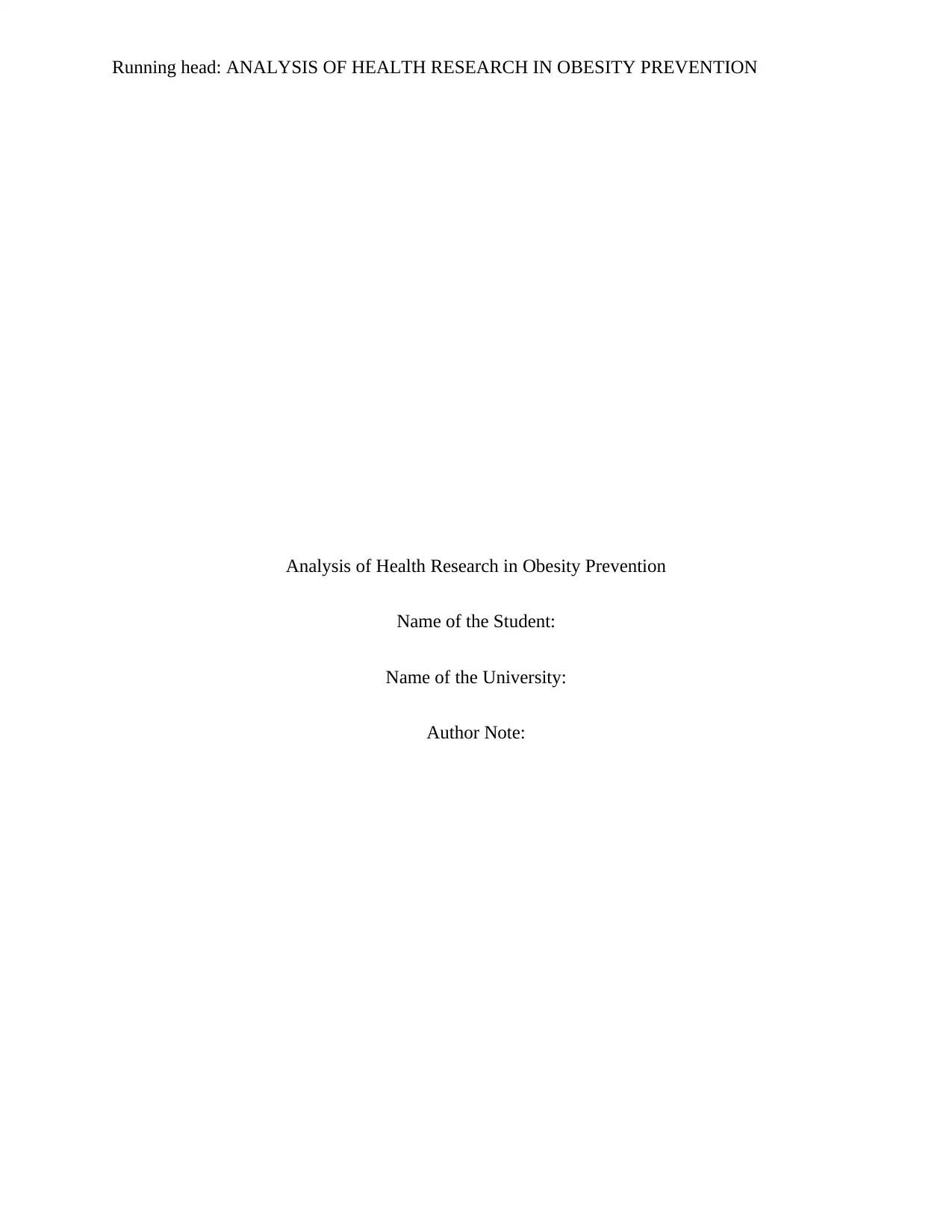
Running head: ANALYSIS OF HEALTH RESEARCH IN OBESITY PREVENTION
Analysis of Health Research in Obesity Prevention
Name of the Student:
Name of the University:
Author Note:
Analysis of Health Research in Obesity Prevention
Name of the Student:
Name of the University:
Author Note:
Paraphrase This Document
Need a fresh take? Get an instant paraphrase of this document with our AI Paraphraser

1ANALYSIS OF HEALTH RESEARCH IN OBESITY PREVENTION
Table of Contents
Introduction......................................................................................................................................2
Purpose of the study.........................................................................................................................2
Method of the study.........................................................................................................................3
Evolution procedures.......................................................................................................................4
Measures..........................................................................................................................................5
Statistical analysis............................................................................................................................6
Discussion........................................................................................................................................8
Conclusion.......................................................................................................................................8
References......................................................................................................................................10
Table of Contents
Introduction......................................................................................................................................2
Purpose of the study.........................................................................................................................2
Method of the study.........................................................................................................................3
Evolution procedures.......................................................................................................................4
Measures..........................................................................................................................................5
Statistical analysis............................................................................................................................6
Discussion........................................................................................................................................8
Conclusion.......................................................................................................................................8
References......................................................................................................................................10

2ANALYSIS OF HEALTH RESEARCH IN OBESITY PREVENTION
Introduction
The purpose of this article is to describe the importance of healthy eating and physical
activity in order to control the obesity of Latino children. The issue of obesity of school children
is really alarming and appropriate preventive measures should be taken as early as possible. This
paper broadly explains the analysis for the prevention of childhood obesity proceeds with
explaining the impact of the interventions conducted by the Community Health Advisor (also
known as promotora) for controlling and preventing the childhood overweight and obesity
(Rossen, 2014). These interventions are performed by randomizing some elementary schools in
Latin America. This type of intervention is known as promotora based behavioral intervention.
According to a study, about 25% of Mexican children of age group 6 to 11 years are suffered by
the problem of obesity where 19% of non-Hispanic Blacks and 19% of non-Hispanic Whites also
suffer from obesity and overweight issues. The proposed study proceeds through the application
of statistical analysis that is, factorial designs to evaluate the effect of the single-level and multi-
level interventions for modifying the ill practices causing obesity. The statistical measure z-
scores of the BMI (Basal Metabolic Rate) rates are calculated and then findings are analyzed to
accomplish the purpose of the study.
Purpose of the study
The study aims to provide solutions to control and prevent overweight and obesity related
issue of Latino children of 6-11 years of age in order to reduce the chance of life-threatening
diseases in future. Childhood obesity persists till the early adulthood period and the obesity is
also a cause of developing diabetes in the body of Latino children (Ndisang, Vannacci &
Rastogi, 2014). Moreover, Latino children are more prone to the risk of diabetes than non-
Introduction
The purpose of this article is to describe the importance of healthy eating and physical
activity in order to control the obesity of Latino children. The issue of obesity of school children
is really alarming and appropriate preventive measures should be taken as early as possible. This
paper broadly explains the analysis for the prevention of childhood obesity proceeds with
explaining the impact of the interventions conducted by the Community Health Advisor (also
known as promotora) for controlling and preventing the childhood overweight and obesity
(Rossen, 2014). These interventions are performed by randomizing some elementary schools in
Latin America. This type of intervention is known as promotora based behavioral intervention.
According to a study, about 25% of Mexican children of age group 6 to 11 years are suffered by
the problem of obesity where 19% of non-Hispanic Blacks and 19% of non-Hispanic Whites also
suffer from obesity and overweight issues. The proposed study proceeds through the application
of statistical analysis that is, factorial designs to evaluate the effect of the single-level and multi-
level interventions for modifying the ill practices causing obesity. The statistical measure z-
scores of the BMI (Basal Metabolic Rate) rates are calculated and then findings are analyzed to
accomplish the purpose of the study.
Purpose of the study
The study aims to provide solutions to control and prevent overweight and obesity related
issue of Latino children of 6-11 years of age in order to reduce the chance of life-threatening
diseases in future. Childhood obesity persists till the early adulthood period and the obesity is
also a cause of developing diabetes in the body of Latino children (Ndisang, Vannacci &
Rastogi, 2014). Moreover, Latino children are more prone to the risk of diabetes than non-
⊘ This is a preview!⊘
Do you want full access?
Subscribe today to unlock all pages.

Trusted by 1+ million students worldwide

3ANALYSIS OF HEALTH RESEARCH IN OBESITY PREVENTION
Hispanic Blacks and Whites (Hoelscher et al., 2015). Therefore, the given study comes with a
social cause to provide solutions to prevent obesity. In addition to this, it will help to promote the
healthy habits that claim to reduce the obesity of the Latino children.
Method of the study
The study provides the significance of promotora based intervention on multi-level using
the factorial design experiment. For that purpose, it is required to collect the samples to conduct
the statistical analysis and therefore the data were collected. The study has used primary data
sources. Thus, the data were collected from thirteen schools selected randomly. The thirteen
schools were randomly gone through the Aventuras para Niños (APN) study which is a 3-year, 2
× 2 factorial design randomized controlled community subgroup trial and the schools were
divided into four sub-groups namely, Family (Fam-only), Community (Comm-only),
Combination of Family and Community (Fam+Comm), and subgroup of no-treatment control
(Ayeni et al., 2013). Initially, twenty-five schools were sorted out. Among the, five were not
eligible and seven were not interested for the study. 808 Latino parents and their children
participated in the study who were enrolled to the 2nd grade of the schools. The quantity that has
been taken into account, is the BMI rate of the parents and their children. The main targeted
variable is the parenting variable that causes the change in intervention of the Fam-only
subgroup. This statistical analysis utilizes the BMI z-scores (Flegaldi & Cole, 2013) to interpret
the multi-level promotora based impact. The schools had to satisfy certain eligibility criteria
which are as follows:
i. Minimum 70% enrollment of the Latino children.
ii. An attendance criteria has been defined.
iii. Teachers should not undergo any physical training program in the past four years.
Hispanic Blacks and Whites (Hoelscher et al., 2015). Therefore, the given study comes with a
social cause to provide solutions to prevent obesity. In addition to this, it will help to promote the
healthy habits that claim to reduce the obesity of the Latino children.
Method of the study
The study provides the significance of promotora based intervention on multi-level using
the factorial design experiment. For that purpose, it is required to collect the samples to conduct
the statistical analysis and therefore the data were collected. The study has used primary data
sources. Thus, the data were collected from thirteen schools selected randomly. The thirteen
schools were randomly gone through the Aventuras para Niños (APN) study which is a 3-year, 2
× 2 factorial design randomized controlled community subgroup trial and the schools were
divided into four sub-groups namely, Family (Fam-only), Community (Comm-only),
Combination of Family and Community (Fam+Comm), and subgroup of no-treatment control
(Ayeni et al., 2013). Initially, twenty-five schools were sorted out. Among the, five were not
eligible and seven were not interested for the study. 808 Latino parents and their children
participated in the study who were enrolled to the 2nd grade of the schools. The quantity that has
been taken into account, is the BMI rate of the parents and their children. The main targeted
variable is the parenting variable that causes the change in intervention of the Fam-only
subgroup. This statistical analysis utilizes the BMI z-scores (Flegaldi & Cole, 2013) to interpret
the multi-level promotora based impact. The schools had to satisfy certain eligibility criteria
which are as follows:
i. Minimum 70% enrollment of the Latino children.
ii. An attendance criteria has been defined.
iii. Teachers should not undergo any physical training program in the past four years.
Paraphrase This Document
Need a fresh take? Get an instant paraphrase of this document with our AI Paraphraser
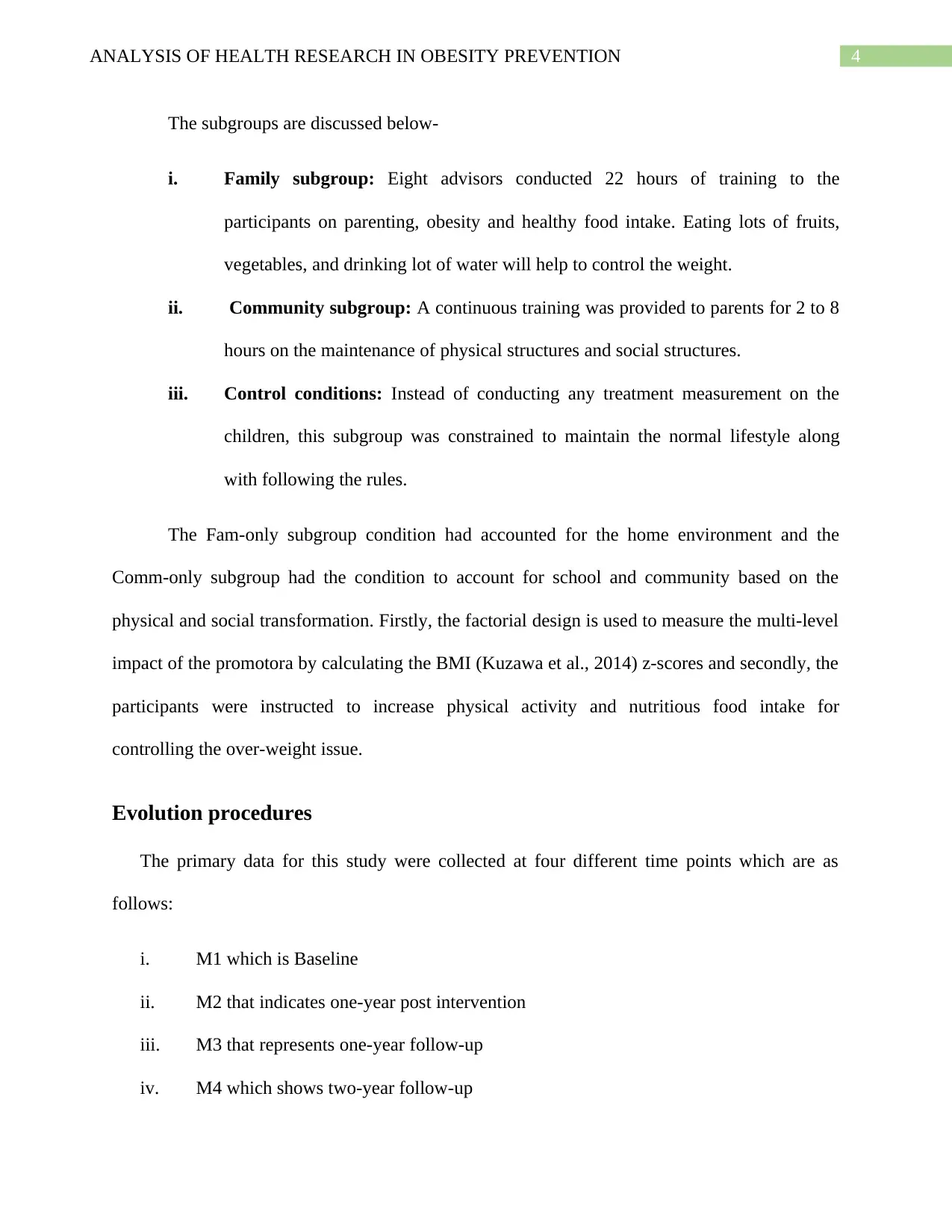
4ANALYSIS OF HEALTH RESEARCH IN OBESITY PREVENTION
The subgroups are discussed below-
i. Family subgroup: Eight advisors conducted 22 hours of training to the
participants on parenting, obesity and healthy food intake. Eating lots of fruits,
vegetables, and drinking lot of water will help to control the weight.
ii. Community subgroup: A continuous training was provided to parents for 2 to 8
hours on the maintenance of physical structures and social structures.
iii. Control conditions: Instead of conducting any treatment measurement on the
children, this subgroup was constrained to maintain the normal lifestyle along
with following the rules.
The Fam-only subgroup condition had accounted for the home environment and the
Comm-only subgroup had the condition to account for school and community based on the
physical and social transformation. Firstly, the factorial design is used to measure the multi-level
impact of the promotora by calculating the BMI (Kuzawa et al., 2014) z-scores and secondly, the
participants were instructed to increase physical activity and nutritious food intake for
controlling the over-weight issue.
Evolution procedures
The primary data for this study were collected at four different time points which are as
follows:
i. M1 which is Baseline
ii. M2 that indicates one-year post intervention
iii. M3 that represents one-year follow-up
iv. M4 which shows two-year follow-up
The subgroups are discussed below-
i. Family subgroup: Eight advisors conducted 22 hours of training to the
participants on parenting, obesity and healthy food intake. Eating lots of fruits,
vegetables, and drinking lot of water will help to control the weight.
ii. Community subgroup: A continuous training was provided to parents for 2 to 8
hours on the maintenance of physical structures and social structures.
iii. Control conditions: Instead of conducting any treatment measurement on the
children, this subgroup was constrained to maintain the normal lifestyle along
with following the rules.
The Fam-only subgroup condition had accounted for the home environment and the
Comm-only subgroup had the condition to account for school and community based on the
physical and social transformation. Firstly, the factorial design is used to measure the multi-level
impact of the promotora by calculating the BMI (Kuzawa et al., 2014) z-scores and secondly, the
participants were instructed to increase physical activity and nutritious food intake for
controlling the over-weight issue.
Evolution procedures
The primary data for this study were collected at four different time points which are as
follows:
i. M1 which is Baseline
ii. M2 that indicates one-year post intervention
iii. M3 that represents one-year follow-up
iv. M4 which shows two-year follow-up
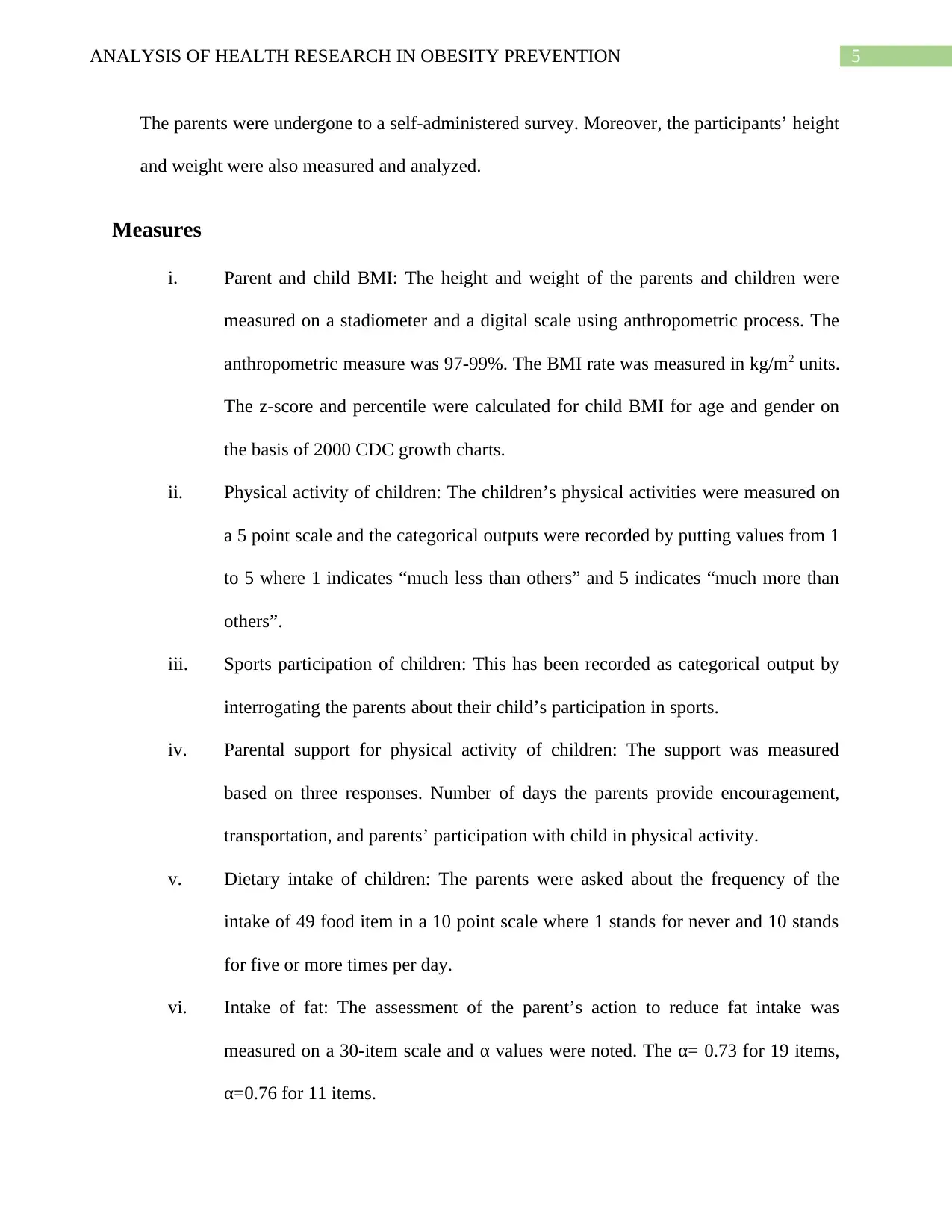
5ANALYSIS OF HEALTH RESEARCH IN OBESITY PREVENTION
The parents were undergone to a self-administered survey. Moreover, the participants’ height
and weight were also measured and analyzed.
Measures
i. Parent and child BMI: The height and weight of the parents and children were
measured on a stadiometer and a digital scale using anthropometric process. The
anthropometric measure was 97-99%. The BMI rate was measured in kg/m2 units.
The z-score and percentile were calculated for child BMI for age and gender on
the basis of 2000 CDC growth charts.
ii. Physical activity of children: The children’s physical activities were measured on
a 5 point scale and the categorical outputs were recorded by putting values from 1
to 5 where 1 indicates “much less than others” and 5 indicates “much more than
others”.
iii. Sports participation of children: This has been recorded as categorical output by
interrogating the parents about their child’s participation in sports.
iv. Parental support for physical activity of children: The support was measured
based on three responses. Number of days the parents provide encouragement,
transportation, and parents’ participation with child in physical activity.
v. Dietary intake of children: The parents were asked about the frequency of the
intake of 49 food item in a 10 point scale where 1 stands for never and 10 stands
for five or more times per day.
vi. Intake of fat: The assessment of the parent’s action to reduce fat intake was
measured on a 30-item scale and α values were noted. The α= 0.73 for 19 items,
α=0.76 for 11 items.
The parents were undergone to a self-administered survey. Moreover, the participants’ height
and weight were also measured and analyzed.
Measures
i. Parent and child BMI: The height and weight of the parents and children were
measured on a stadiometer and a digital scale using anthropometric process. The
anthropometric measure was 97-99%. The BMI rate was measured in kg/m2 units.
The z-score and percentile were calculated for child BMI for age and gender on
the basis of 2000 CDC growth charts.
ii. Physical activity of children: The children’s physical activities were measured on
a 5 point scale and the categorical outputs were recorded by putting values from 1
to 5 where 1 indicates “much less than others” and 5 indicates “much more than
others”.
iii. Sports participation of children: This has been recorded as categorical output by
interrogating the parents about their child’s participation in sports.
iv. Parental support for physical activity of children: The support was measured
based on three responses. Number of days the parents provide encouragement,
transportation, and parents’ participation with child in physical activity.
v. Dietary intake of children: The parents were asked about the frequency of the
intake of 49 food item in a 10 point scale where 1 stands for never and 10 stands
for five or more times per day.
vi. Intake of fat: The assessment of the parent’s action to reduce fat intake was
measured on a 30-item scale and α values were noted. The α= 0.73 for 19 items,
α=0.76 for 11 items.
⊘ This is a preview!⊘
Do you want full access?
Subscribe today to unlock all pages.

Trusted by 1+ million students worldwide
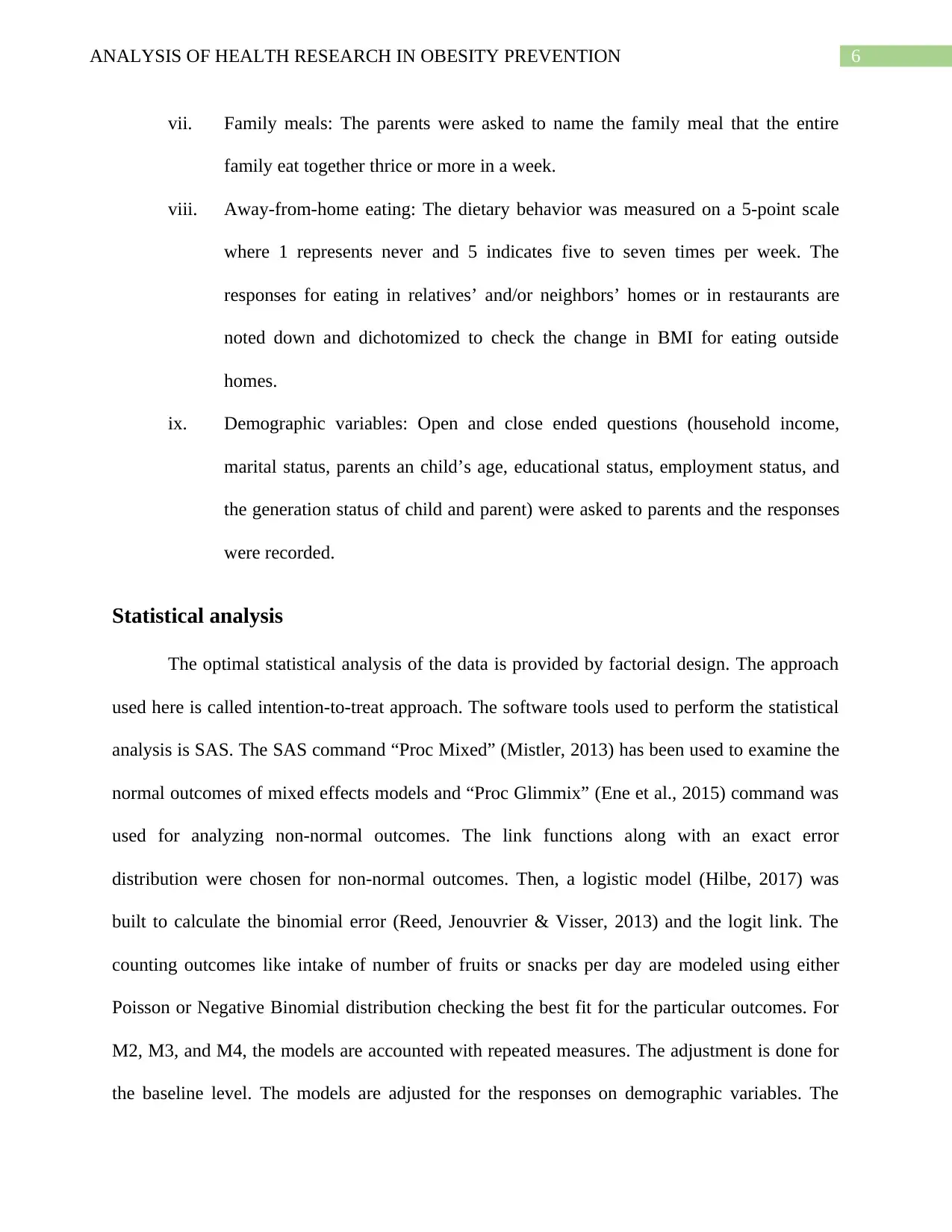
6ANALYSIS OF HEALTH RESEARCH IN OBESITY PREVENTION
vii. Family meals: The parents were asked to name the family meal that the entire
family eat together thrice or more in a week.
viii. Away-from-home eating: The dietary behavior was measured on a 5-point scale
where 1 represents never and 5 indicates five to seven times per week. The
responses for eating in relatives’ and/or neighbors’ homes or in restaurants are
noted down and dichotomized to check the change in BMI for eating outside
homes.
ix. Demographic variables: Open and close ended questions (household income,
marital status, parents an child’s age, educational status, employment status, and
the generation status of child and parent) were asked to parents and the responses
were recorded.
Statistical analysis
The optimal statistical analysis of the data is provided by factorial design. The approach
used here is called intention-to-treat approach. The software tools used to perform the statistical
analysis is SAS. The SAS command “Proc Mixed” (Mistler, 2013) has been used to examine the
normal outcomes of mixed effects models and “Proc Glimmix” (Ene et al., 2015) command was
used for analyzing non-normal outcomes. The link functions along with an exact error
distribution were chosen for non-normal outcomes. Then, a logistic model (Hilbe, 2017) was
built to calculate the binomial error (Reed, Jenouvrier & Visser, 2013) and the logit link. The
counting outcomes like intake of number of fruits or snacks per day are modeled using either
Poisson or Negative Binomial distribution checking the best fit for the particular outcomes. For
M2, M3, and M4, the models are accounted with repeated measures. The adjustment is done for
the baseline level. The models are adjusted for the responses on demographic variables. The
vii. Family meals: The parents were asked to name the family meal that the entire
family eat together thrice or more in a week.
viii. Away-from-home eating: The dietary behavior was measured on a 5-point scale
where 1 represents never and 5 indicates five to seven times per week. The
responses for eating in relatives’ and/or neighbors’ homes or in restaurants are
noted down and dichotomized to check the change in BMI for eating outside
homes.
ix. Demographic variables: Open and close ended questions (household income,
marital status, parents an child’s age, educational status, employment status, and
the generation status of child and parent) were asked to parents and the responses
were recorded.
Statistical analysis
The optimal statistical analysis of the data is provided by factorial design. The approach
used here is called intention-to-treat approach. The software tools used to perform the statistical
analysis is SAS. The SAS command “Proc Mixed” (Mistler, 2013) has been used to examine the
normal outcomes of mixed effects models and “Proc Glimmix” (Ene et al., 2015) command was
used for analyzing non-normal outcomes. The link functions along with an exact error
distribution were chosen for non-normal outcomes. Then, a logistic model (Hilbe, 2017) was
built to calculate the binomial error (Reed, Jenouvrier & Visser, 2013) and the logit link. The
counting outcomes like intake of number of fruits or snacks per day are modeled using either
Poisson or Negative Binomial distribution checking the best fit for the particular outcomes. For
M2, M3, and M4, the models are accounted with repeated measures. The adjustment is done for
the baseline level. The models are adjusted for the responses on demographic variables. The
Paraphrase This Document
Need a fresh take? Get an instant paraphrase of this document with our AI Paraphraser
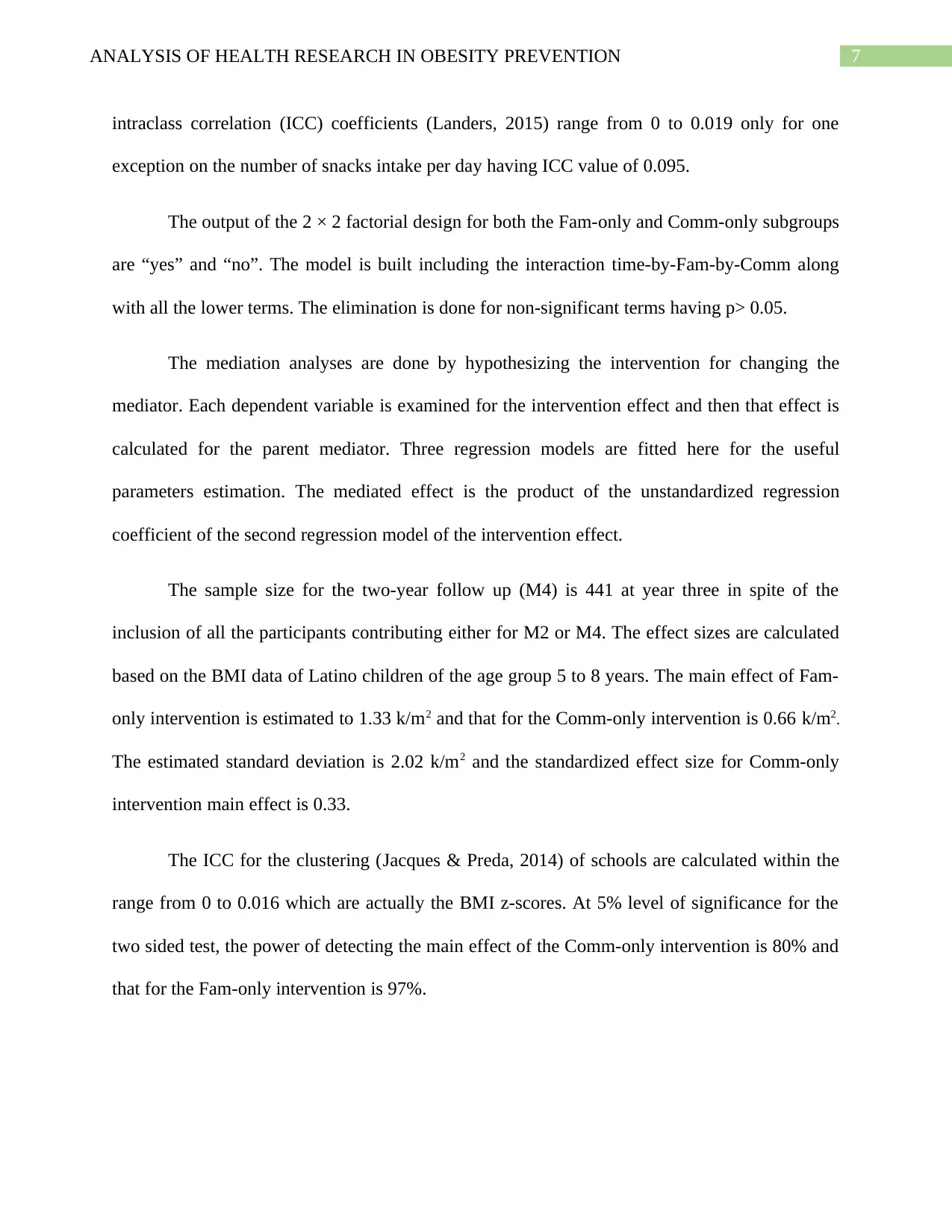
7ANALYSIS OF HEALTH RESEARCH IN OBESITY PREVENTION
intraclass correlation (ICC) coefficients (Landers, 2015) range from 0 to 0.019 only for one
exception on the number of snacks intake per day having ICC value of 0.095.
The output of the 2 × 2 factorial design for both the Fam-only and Comm-only subgroups
are “yes” and “no”. The model is built including the interaction time-by-Fam-by-Comm along
with all the lower terms. The elimination is done for non-significant terms having p> 0.05.
The mediation analyses are done by hypothesizing the intervention for changing the
mediator. Each dependent variable is examined for the intervention effect and then that effect is
calculated for the parent mediator. Three regression models are fitted here for the useful
parameters estimation. The mediated effect is the product of the unstandardized regression
coefficient of the second regression model of the intervention effect.
The sample size for the two-year follow up (M4) is 441 at year three in spite of the
inclusion of all the participants contributing either for M2 or M4. The effect sizes are calculated
based on the BMI data of Latino children of the age group 5 to 8 years. The main effect of Fam-
only intervention is estimated to 1.33 k/m2 and that for the Comm-only intervention is 0.66 k/m2.
The estimated standard deviation is 2.02 k/m2 and the standardized effect size for Comm-only
intervention main effect is 0.33.
The ICC for the clustering (Jacques & Preda, 2014) of schools are calculated within the
range from 0 to 0.016 which are actually the BMI z-scores. At 5% level of significance for the
two sided test, the power of detecting the main effect of the Comm-only intervention is 80% and
that for the Fam-only intervention is 97%.
intraclass correlation (ICC) coefficients (Landers, 2015) range from 0 to 0.019 only for one
exception on the number of snacks intake per day having ICC value of 0.095.
The output of the 2 × 2 factorial design for both the Fam-only and Comm-only subgroups
are “yes” and “no”. The model is built including the interaction time-by-Fam-by-Comm along
with all the lower terms. The elimination is done for non-significant terms having p> 0.05.
The mediation analyses are done by hypothesizing the intervention for changing the
mediator. Each dependent variable is examined for the intervention effect and then that effect is
calculated for the parent mediator. Three regression models are fitted here for the useful
parameters estimation. The mediated effect is the product of the unstandardized regression
coefficient of the second regression model of the intervention effect.
The sample size for the two-year follow up (M4) is 441 at year three in spite of the
inclusion of all the participants contributing either for M2 or M4. The effect sizes are calculated
based on the BMI data of Latino children of the age group 5 to 8 years. The main effect of Fam-
only intervention is estimated to 1.33 k/m2 and that for the Comm-only intervention is 0.66 k/m2.
The estimated standard deviation is 2.02 k/m2 and the standardized effect size for Comm-only
intervention main effect is 0.33.
The ICC for the clustering (Jacques & Preda, 2014) of schools are calculated within the
range from 0 to 0.016 which are actually the BMI z-scores. At 5% level of significance for the
two sided test, the power of detecting the main effect of the Comm-only intervention is 80% and
that for the Fam-only intervention is 97%.

8ANALYSIS OF HEALTH RESEARCH IN OBESITY PREVENTION
Discussion
The study is developed on the basis of the examination of the intervention of the family
and the community environments. The hypothesis of test is that, the combined intervention of
family and community has more impact on the BMI z-score of children than single impact of
family intervention and community intervention (Bates et al., 2014). The findings explains that
significant changes are not present in any of the intervention subgroups. The probable
explanations for the null hypothesis have a wide variability. The significant behavioral changes
of the parents and children are measured as a degree product of the facts and the outcomes are
measured based on the values of the height variable of children and parents. There has been
heterogeneity in the BMI z-scores of the participants at M1 (Wang, Zhang & Fu, 2016). The
community intervention is heterogeneous in nature and it contrasts with the clinical intervention
that target the risk levels. The BMI z-scores range from 41% to 52% within the four sub-groups.
The primary analyses are performed in the light of data collected from M1 to M4. The overall
retention rate is shown as 55% in the analyses and the condition based retention rates are 48%
for Fam-only, for Comm-only it is 59%. In case of the combination Fam+Comm, the rate is 50%
and lastly 59% for the control intervention.
Conclusion
From the above study, it can be concluded that many essential improvisations have been
achieved by interpreting the intervention effects which are obtained from the calculated BMI z-
scores of the children, their percentiles and proportions of children belonging to the obese
category. It has been found that BMI z-scores have increased always throughout the course of the
analyses. Moreover, the proportion of obese children has also been increased. The effect of
significant intervention of child BMI and parent BMI are negligible. Again, the interaction effect
Discussion
The study is developed on the basis of the examination of the intervention of the family
and the community environments. The hypothesis of test is that, the combined intervention of
family and community has more impact on the BMI z-score of children than single impact of
family intervention and community intervention (Bates et al., 2014). The findings explains that
significant changes are not present in any of the intervention subgroups. The probable
explanations for the null hypothesis have a wide variability. The significant behavioral changes
of the parents and children are measured as a degree product of the facts and the outcomes are
measured based on the values of the height variable of children and parents. There has been
heterogeneity in the BMI z-scores of the participants at M1 (Wang, Zhang & Fu, 2016). The
community intervention is heterogeneous in nature and it contrasts with the clinical intervention
that target the risk levels. The BMI z-scores range from 41% to 52% within the four sub-groups.
The primary analyses are performed in the light of data collected from M1 to M4. The overall
retention rate is shown as 55% in the analyses and the condition based retention rates are 48%
for Fam-only, for Comm-only it is 59%. In case of the combination Fam+Comm, the rate is 50%
and lastly 59% for the control intervention.
Conclusion
From the above study, it can be concluded that many essential improvisations have been
achieved by interpreting the intervention effects which are obtained from the calculated BMI z-
scores of the children, their percentiles and proportions of children belonging to the obese
category. It has been found that BMI z-scores have increased always throughout the course of the
analyses. Moreover, the proportion of obese children has also been increased. The effect of
significant intervention of child BMI and parent BMI are negligible. Again, the interaction effect
⊘ This is a preview!⊘
Do you want full access?
Subscribe today to unlock all pages.

Trusted by 1+ million students worldwide
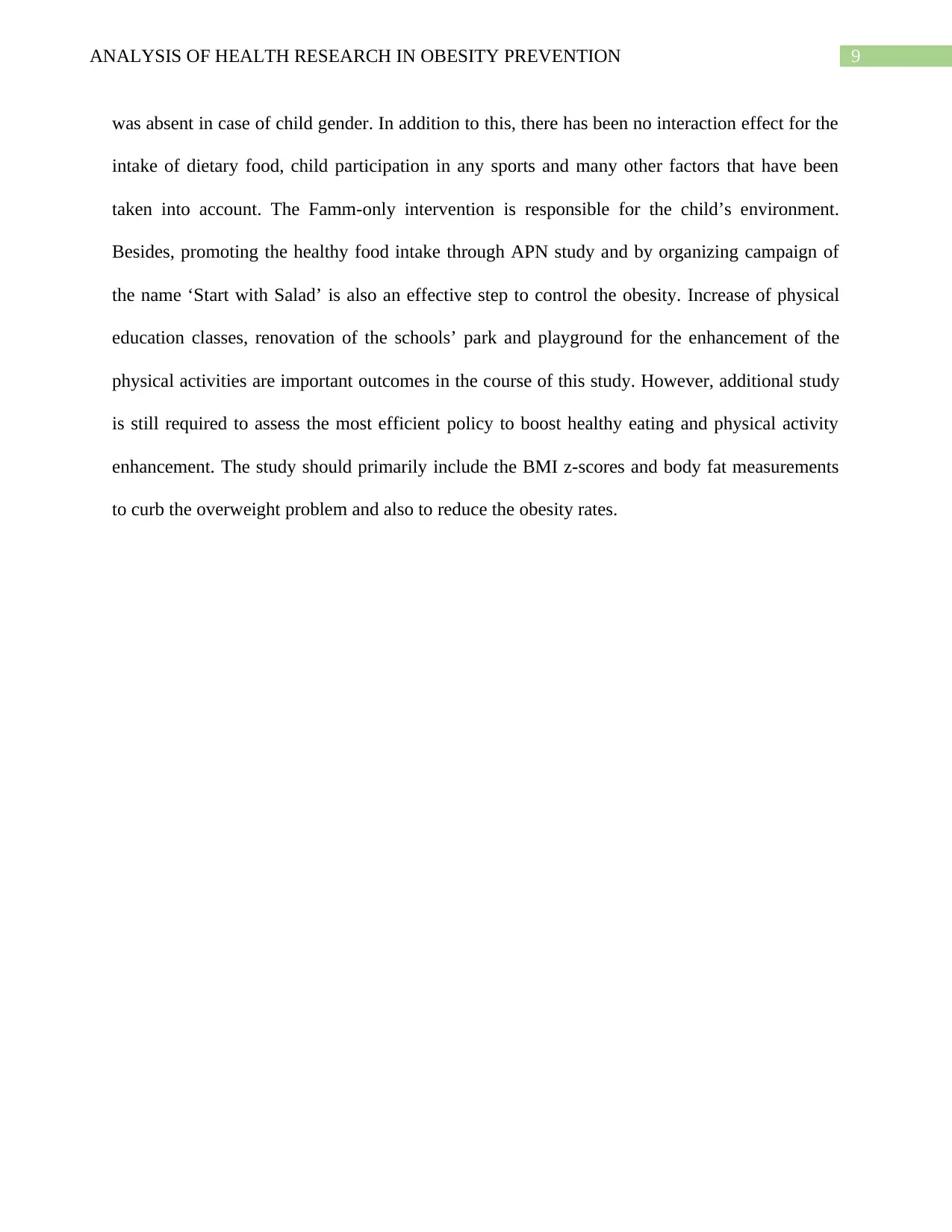
9ANALYSIS OF HEALTH RESEARCH IN OBESITY PREVENTION
was absent in case of child gender. In addition to this, there has been no interaction effect for the
intake of dietary food, child participation in any sports and many other factors that have been
taken into account. The Famm-only intervention is responsible for the child’s environment.
Besides, promoting the healthy food intake through APN study and by organizing campaign of
the name ‘Start with Salad’ is also an effective step to control the obesity. Increase of physical
education classes, renovation of the schools’ park and playground for the enhancement of the
physical activities are important outcomes in the course of this study. However, additional study
is still required to assess the most efficient policy to boost healthy eating and physical activity
enhancement. The study should primarily include the BMI z-scores and body fat measurements
to curb the overweight problem and also to reduce the obesity rates.
was absent in case of child gender. In addition to this, there has been no interaction effect for the
intake of dietary food, child participation in any sports and many other factors that have been
taken into account. The Famm-only intervention is responsible for the child’s environment.
Besides, promoting the healthy food intake through APN study and by organizing campaign of
the name ‘Start with Salad’ is also an effective step to control the obesity. Increase of physical
education classes, renovation of the schools’ park and playground for the enhancement of the
physical activities are important outcomes in the course of this study. However, additional study
is still required to assess the most efficient policy to boost healthy eating and physical activity
enhancement. The study should primarily include the BMI z-scores and body fat measurements
to curb the overweight problem and also to reduce the obesity rates.
Paraphrase This Document
Need a fresh take? Get an instant paraphrase of this document with our AI Paraphraser

10ANALYSIS OF HEALTH RESEARCH IN OBESITY PREVENTION
References
Ayeni, A. O., Banerjee, S., Omoleye, J. A., Hymore, F. K., Giri, B. S., Deshmukh, S. C., ... &
Mudliar, S. N. (2013). Optimization of pretreatment conditions using full factorial design
and enzymatic convertibility of shea tree sawdust. biomass and bioenergy, 48, 130-138.
Bates, D., Maechler, M., Bolker, B., & Walker, S. (2014). lme4: Linear mixed-effects models
using Eigen and S4. R package version, 1(7), 1-23.
Ene, M., Leighton, E. A., Blue, G. L., & Bell, B. A. (2015, November). Multilevel models for
categorical data using SAS® PROC GLIMMIX: the basics. In SAS Global Forum 2015
Proceedings (pp. 3430-2015).
Flegal, K. M., & Cole, T. J. (2013). Construction of LMS parameters for the Centers for Disease
Control and Prevention 2000 growth charts (No. 63). US Department of Health and
Human Services, Centers for Disease Control and Prevention, National Center for Health
Statistics.
Hilbe, J. M. (2017). Logistic regression models. CRC press.
Hoelscher, D. M., Butte, N. F., Barlow, S., Vandewater, E. A., Sharma, S. V., Huang, T., ... &
Oluyomi, A. O. (2015). Incorporating primary and secondary prevention approaches to
address childhood obesity prevention and treatment in a low-income, ethnically diverse
population: study design and demographic data from the Texas Childhood Obesity
Research Demonstration (TX CORD) study. Childhood obesity, 11(1), 71-91.
Jacques, J., & Preda, C. (2014). Model-based clustering for multivariate functional data.
Computational Statistics & Data Analysis, 71, 92-106.
References
Ayeni, A. O., Banerjee, S., Omoleye, J. A., Hymore, F. K., Giri, B. S., Deshmukh, S. C., ... &
Mudliar, S. N. (2013). Optimization of pretreatment conditions using full factorial design
and enzymatic convertibility of shea tree sawdust. biomass and bioenergy, 48, 130-138.
Bates, D., Maechler, M., Bolker, B., & Walker, S. (2014). lme4: Linear mixed-effects models
using Eigen and S4. R package version, 1(7), 1-23.
Ene, M., Leighton, E. A., Blue, G. L., & Bell, B. A. (2015, November). Multilevel models for
categorical data using SAS® PROC GLIMMIX: the basics. In SAS Global Forum 2015
Proceedings (pp. 3430-2015).
Flegal, K. M., & Cole, T. J. (2013). Construction of LMS parameters for the Centers for Disease
Control and Prevention 2000 growth charts (No. 63). US Department of Health and
Human Services, Centers for Disease Control and Prevention, National Center for Health
Statistics.
Hilbe, J. M. (2017). Logistic regression models. CRC press.
Hoelscher, D. M., Butte, N. F., Barlow, S., Vandewater, E. A., Sharma, S. V., Huang, T., ... &
Oluyomi, A. O. (2015). Incorporating primary and secondary prevention approaches to
address childhood obesity prevention and treatment in a low-income, ethnically diverse
population: study design and demographic data from the Texas Childhood Obesity
Research Demonstration (TX CORD) study. Childhood obesity, 11(1), 71-91.
Jacques, J., & Preda, C. (2014). Model-based clustering for multivariate functional data.
Computational Statistics & Data Analysis, 71, 92-106.
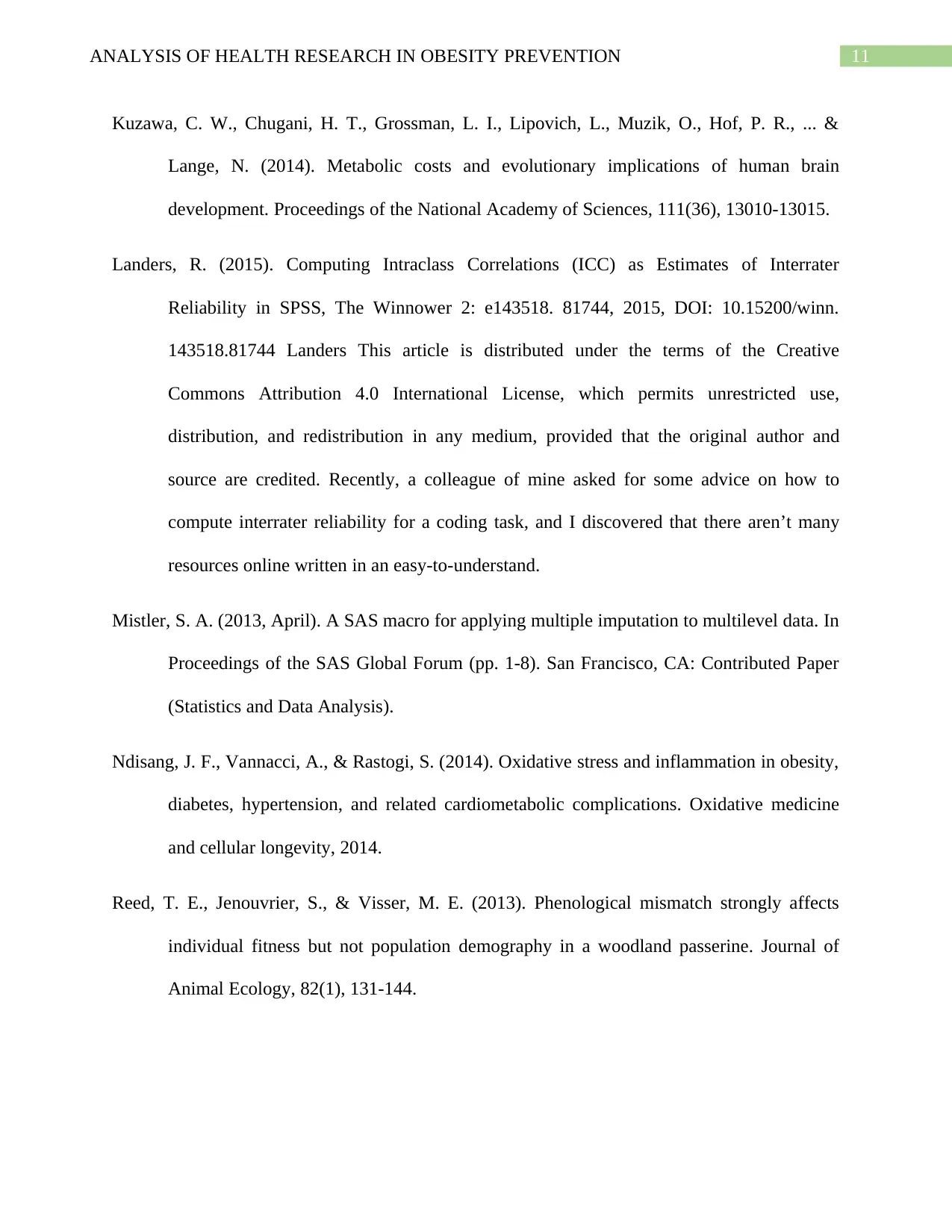
11ANALYSIS OF HEALTH RESEARCH IN OBESITY PREVENTION
Kuzawa, C. W., Chugani, H. T., Grossman, L. I., Lipovich, L., Muzik, O., Hof, P. R., ... &
Lange, N. (2014). Metabolic costs and evolutionary implications of human brain
development. Proceedings of the National Academy of Sciences, 111(36), 13010-13015.
Landers, R. (2015). Computing Intraclass Correlations (ICC) as Estimates of Interrater
Reliability in SPSS, The Winnower 2: e143518. 81744, 2015, DOI: 10.15200/winn.
143518.81744 Landers This article is distributed under the terms of the Creative
Commons Attribution 4.0 International License, which permits unrestricted use,
distribution, and redistribution in any medium, provided that the original author and
source are credited. Recently, a colleague of mine asked for some advice on how to
compute interrater reliability for a coding task, and I discovered that there aren’t many
resources online written in an easy-to-understand.
Mistler, S. A. (2013, April). A SAS macro for applying multiple imputation to multilevel data. In
Proceedings of the SAS Global Forum (pp. 1-8). San Francisco, CA: Contributed Paper
(Statistics and Data Analysis).
Ndisang, J. F., Vannacci, A., & Rastogi, S. (2014). Oxidative stress and inflammation in obesity,
diabetes, hypertension, and related cardiometabolic complications. Oxidative medicine
and cellular longevity, 2014.
Reed, T. E., Jenouvrier, S., & Visser, M. E. (2013). Phenological mismatch strongly affects
individual fitness but not population demography in a woodland passerine. Journal of
Animal Ecology, 82(1), 131-144.
Kuzawa, C. W., Chugani, H. T., Grossman, L. I., Lipovich, L., Muzik, O., Hof, P. R., ... &
Lange, N. (2014). Metabolic costs and evolutionary implications of human brain
development. Proceedings of the National Academy of Sciences, 111(36), 13010-13015.
Landers, R. (2015). Computing Intraclass Correlations (ICC) as Estimates of Interrater
Reliability in SPSS, The Winnower 2: e143518. 81744, 2015, DOI: 10.15200/winn.
143518.81744 Landers This article is distributed under the terms of the Creative
Commons Attribution 4.0 International License, which permits unrestricted use,
distribution, and redistribution in any medium, provided that the original author and
source are credited. Recently, a colleague of mine asked for some advice on how to
compute interrater reliability for a coding task, and I discovered that there aren’t many
resources online written in an easy-to-understand.
Mistler, S. A. (2013, April). A SAS macro for applying multiple imputation to multilevel data. In
Proceedings of the SAS Global Forum (pp. 1-8). San Francisco, CA: Contributed Paper
(Statistics and Data Analysis).
Ndisang, J. F., Vannacci, A., & Rastogi, S. (2014). Oxidative stress and inflammation in obesity,
diabetes, hypertension, and related cardiometabolic complications. Oxidative medicine
and cellular longevity, 2014.
Reed, T. E., Jenouvrier, S., & Visser, M. E. (2013). Phenological mismatch strongly affects
individual fitness but not population demography in a woodland passerine. Journal of
Animal Ecology, 82(1), 131-144.
⊘ This is a preview!⊘
Do you want full access?
Subscribe today to unlock all pages.

Trusted by 1+ million students worldwide
1 out of 13
Related Documents
Your All-in-One AI-Powered Toolkit for Academic Success.
+13062052269
info@desklib.com
Available 24*7 on WhatsApp / Email
![[object Object]](/_next/static/media/star-bottom.7253800d.svg)
Unlock your academic potential
Copyright © 2020–2026 A2Z Services. All Rights Reserved. Developed and managed by ZUCOL.





